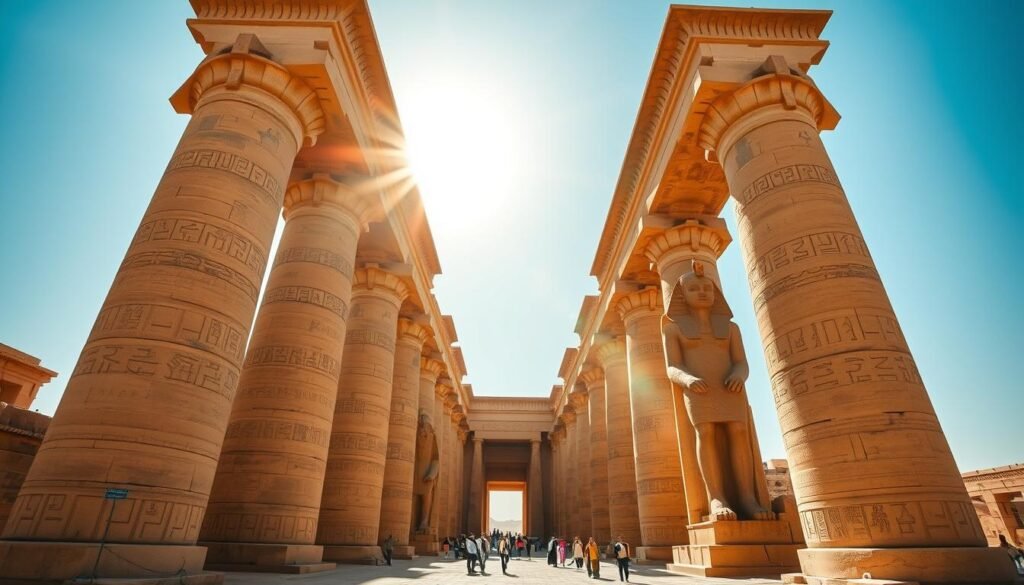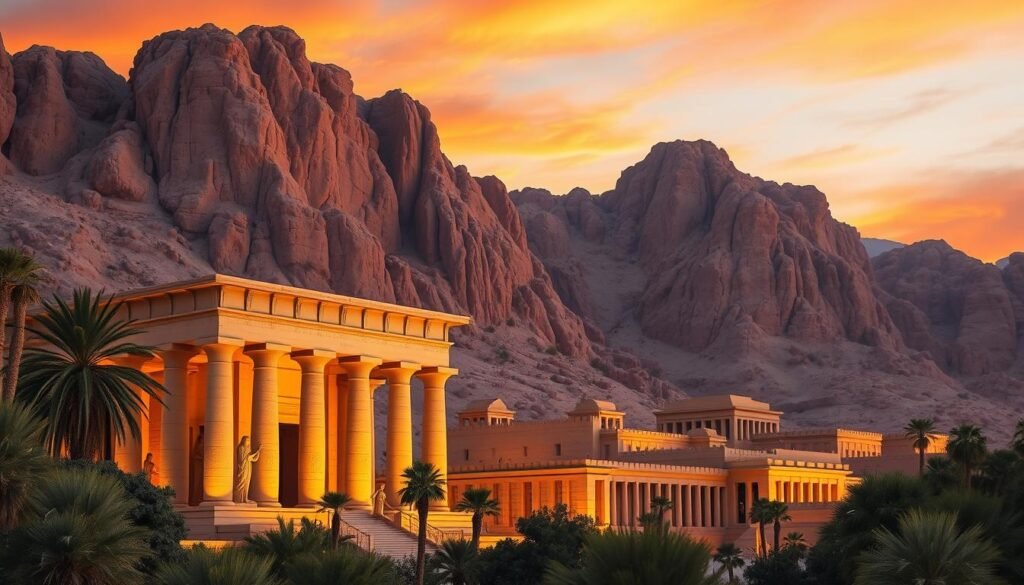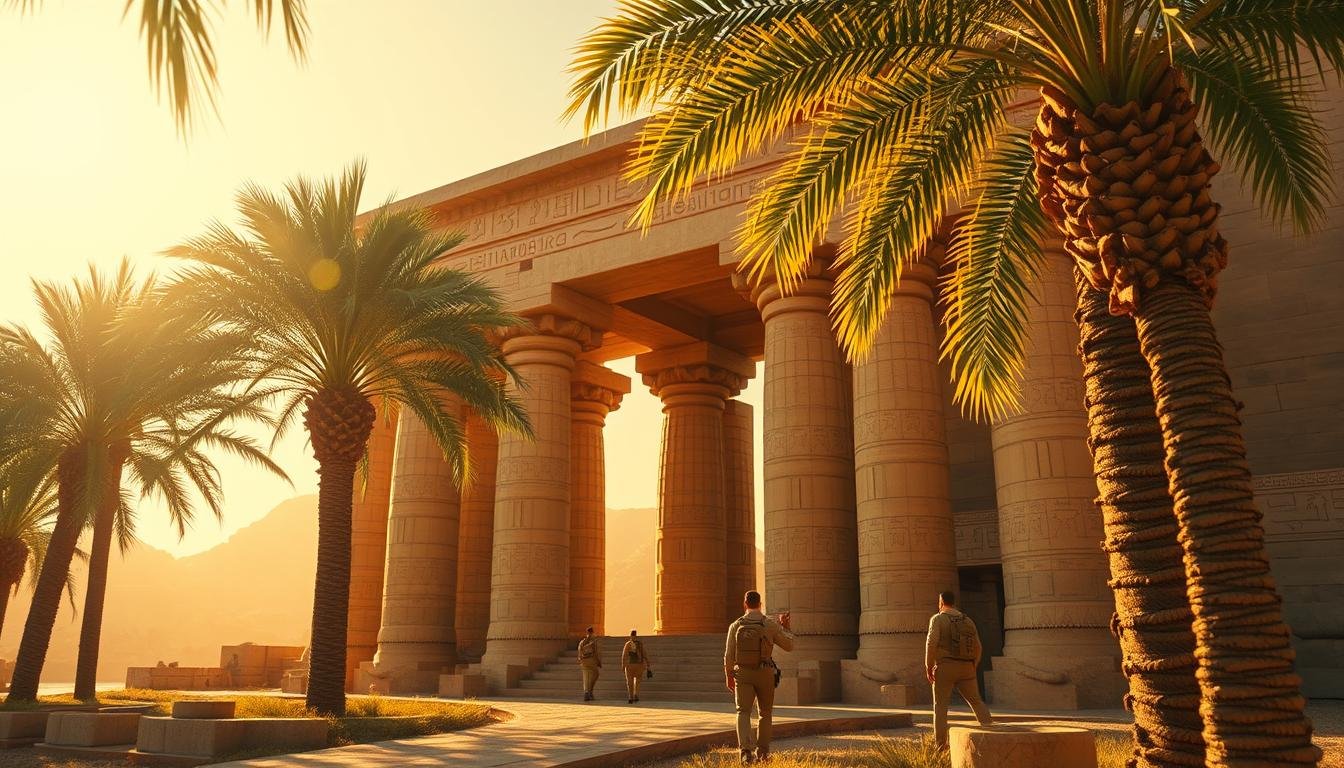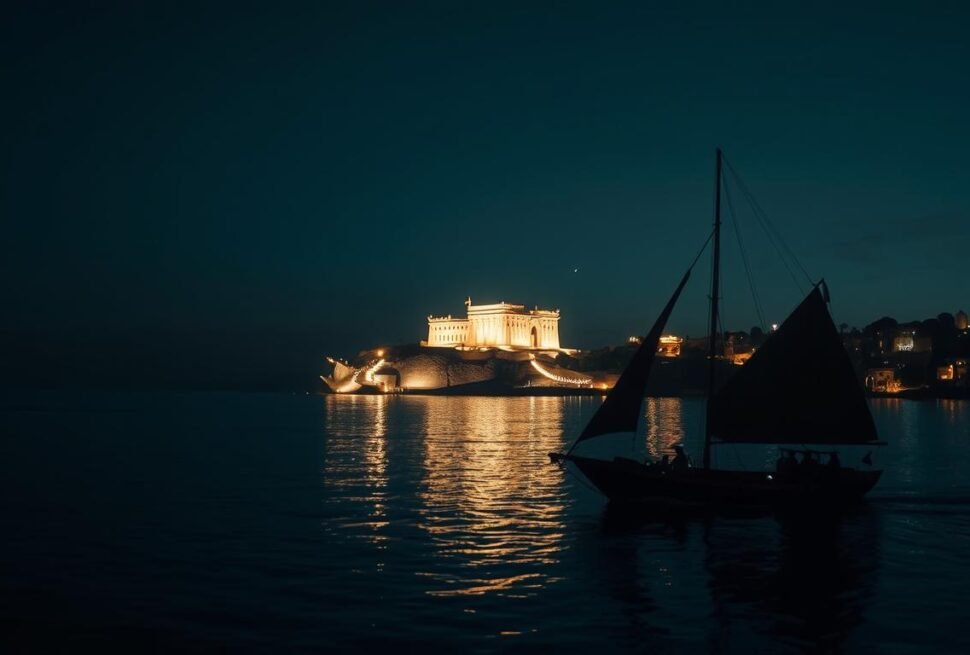What if you could walk through history’s greatest open-air museum, where every stone tells a story thousands of years old?
Imagine standing before colossal statues and towering columns that have witnessed civilizations rise and fall. This journey along Egypt’s lifeblood river offers more than just sightseeing—it’s a portal to another time.
The route from Luxor to Aswan presents the world’s most spectacular concentration of sacred sites. These architectural marvels showcase incredible craftsmanship and deep spiritual meaning.
Organized tours make exploring both convenient and secure. You’ll discover famous landmarks and hidden gems while cruising peacefully on the water.
This adventure blends awe-inspiring history with stunning natural beauty. Get ready for an experience that will stay with you forever.
Key Takeaways
- Explore incredible historical sites along Egypt’s famous river
- Discover both well-known and hidden architectural treasures
- Learn about fascinating stories and mythology carved in stone
- Enjoy safe and convenient organized tour options
- Experience perfect combination of history and beautiful scenery
- Create memories that will last a lifetime
- Get practical information to plan your perfect trip
Introduction: Your Guide to the Ancient Temples Along the Nile: From Luxor to Aswan
Have you ever dreamed of gliding through history on the world’s most legendary waterway? A Nile River cruise offers this magical experience, connecting you with Egypt’s most spectacular sacred sites in comfort and style.
This journey represents the ultimate way to explore these architectural marvels. You’ll discover both famous landmarks and hidden treasures while enjoying peaceful moments on the water.
Why a Nile Temple Tour is an Unforgettable Experience
A temple tour along this historic river provides something truly special. Unlike typical vacations, this trip combines awe-inspiring history with breathtaking natural beauty.
Small cruise ships create an intimate atmosphere. You’ll form connections with fellow travelers while expert guides bring each site’s stories to life.
The experience balances exploration with relaxation perfectly. Mornings might involve visiting magnificent complexes, while afternoons offer scenic sailing time.
Each sacred place reveals different aspects of Egyptian culture. From massive columned halls to intimate sanctuaries, the variety will amaze you.
The progression from Luxor to Aswan follows both geographical and historical paths. You’ll witness how architectural styles evolved over centuries.
Getting in Touch with Black Camel Tours
Planning your perfect adventure is simple with Black Camel Tours. Their team specializes in creating customized itineraries for this remarkable journey.
Professional Egyptologist guides ensure you gain deep understanding at each site. They transform stone carvings into vivid stories from the past.
The booking process is straightforward and personalized. Their experts help craft an itinerary that matches your interests and schedule perfectly.
Reach out today to start planning your extraordinary trip:
Email: Booking@blackcameltours.com
Phone/WhatsApp: +43 660 9081449 | +201080733101
Website: blackcameltours.com
Don’t hesitate to ask questions about cruise options, temple visits, or travel details. Their friendly team welcomes all inquiries about this incredible experience.
1. The Breathtaking Temple of Hathor at Dendera
What if you discovered a sacred place that many consider Egypt’s most spectacular historical site? The Dendera complex offers this extraordinary experience, standing apart from more crowded destinations with its remarkable preservation and artistic beauty.
This magnificent structure was built during the Greco-Roman period approximately 2,000 years ago. Unlike older sites, its detailed carvings and vibrant colors feel almost contemporary while maintaining deep historical significance.
Unparalleled Ceilings and a Royal Legacy
The temple honors Hathor, the goddess of love, music, and fertility. Her presence permeates every corner of this sacred space through intricate carvings and symbolic artwork.
Look upward to witness one of Egypt’s most stunning architectural features. The recently restored astronomical ceilings display vivid blue and gold scenes that seem to glow with celestial energy.
Outside the main structure, you’ll find a rare historical treasure. A carving shows Cleopatra VII with her son Caesarion, connecting this spiritual place to one of history’s most fascinating rulers.
The interior chambers feature Hathor-faced columns and detailed wall carvings. These atmospheric spaces feel both grand and intimate, creating a powerful connection to the past.
Planning Your Visit to Dendera
Located about 60 kilometers north of Luxor near Qena, this site requires special travel arrangements. Entry costs approximately 300 EGP (around $6 USD), offering incredible value for such an exceptional experience.
The temple’s mostly indoor spaces provide welcome relief from the heat. Minimal walking makes it ideal for hot days when outdoor exploration becomes challenging.
Few Nile cruise itineraries include Dendera, making visits here particularly special. Viking is one cruise line that typically includes this stop in their journey.
You’ll likely encounter resident cats during your visit. For health reasons, please admire them from a distance rather than petting them.
This remarkable site deserves at least two hours for proper appreciation. Its unique combination of artistic beauty and historical significance creates memories that last long after your travel days end.
2. The Immense and Awe-Inspiring Karnak Temple Complex
Picture yourself surrounded by stone giants that have watched history unfold for millennia. This magnificent complex represents one of Egypt’s most visited sites, ranking second only to the Pyramids at Giza in popularity.
The scale here is simply breathtaking. You’re exploring what amounts to the world’s largest religious complex, covering approximately 200 acres of monumental architecture.
Construction spanned an incredible 1,500 years with contributions from more than 30 different pharaohs. Each ruler added their own architectural vision to this ever-evolving sacred space.
Getting Lost in the Great Hypostyle Hall
The Great Hypostyle Hall will leave you speechless. One hundred thirty-four massive sandstone columns create a stone forest reaching up to 21 meters high.
Walking through this space feels both humbling and exhilarating. The columns are so massive they could easily accommodate a modern bus between them.
“The hall was designed to make visitors feel small before the gods, and it succeeds magnificently even today.”
Don’t miss the famous scarab statue located near the sacred lake. Local tradition says circling it seven times brings good luck in love and life.
Queen Hatshepsut’s obelisk stands as the tallest still standing in Egypt. This magnificent monument reaches toward the sky just as she reached for power in a male-dominated world.
Navigating the Scale and Heat of Karnak
This complex demands strategic planning for your visit. The entry fee is 600 EGP (approximately $12 USD), offering excellent value for such an incredible experience.
Practical preparation makes all the difference here:
| Essential Item | Why You Need It | Pro Tip |
|---|---|---|
| Wide-brimmed hat | 95% of the complex has no shade | Light colors reflect heat better |
| Comfortable walking shoes | You’ll cover 2-3 miles of uneven ground | Break them in before your trip |
| Water bottle | Egyptian sun can be relentless | Refill stations available near rest areas |
| Camera with extra memory | You’ll want hundreds of photos | Early morning light creates best shots |
Ram-headed sphinxes line the processional way, representing Amun-Ra, the sun god to whom the main temple is dedicated. These majestic creatures create a dramatic approach to the complex.
For the best photography opportunities, explore the side alleyways and less-traveled paths. You’ll find incredible details away from the main crowds.
Allocate at least three hours for your visit to properly appreciate this immense site. The complex’s sheer size means you could easily spend an entire day discovering its wonders.
Most Nile cruise itineraries include a full morning or afternoon here. Your guide will help you navigate the most important sections efficiently.
This place represents not just a single moment in history but fifteen centuries of architectural evolution. Each corner reveals another layer of stories waiting to be discovered.
3. The Remarkably Preserved Edfu Temple (Temple of Horus)
Have you ever wondered what a complete Egyptian sanctuary looked like in its prime? Edfu offers that rare opportunity, standing as Egypt’s most perfectly preserved sacred structure.
This magnificent complex gives you an authentic glimpse into the past. Its incredible condition makes you feel like you’ve stepped back in time.

Mythology Carved in Stone: The Battle of Horus and Seth
The temple walls tell epic stories from Egyptian mythology. Most dramatic are the scenes showing Horus battling his uncle Seth.
These detailed carvings depict the struggle between order and chaos. Horus represents rightful kingship while Seth symbolizes disruption.
Look for the unique relief showing Horus spearing a hippopotamus. This creature represented Seth in the mythological battle.
“The walls at Edfu preserve one of mythology’s greatest stories – the triumph of light over darkness.”
The massive pylon entrance features these battle scenes in stunning detail. They serve as both decoration and spiritual protection for the sacred space.
Exploring the Best-Preserved Temple in Egypt
Construction took place between 237-57 BC during the Ptolemaic period. The temple honors Horus, the falcon-headed god of protection and kingship.
Being buried under sand for centuries protected the structure remarkably well. This preservation gives us an unparalleled view of traditional Egyptian architecture.
The layout follows classic temple design perfectly:
- Massive pylon entrance with towering gateways
- Open courtyard for public gatherings
- Columned hypostyle hall for ceremonies
- Inner sanctuary containing the god’s statue
Don’t miss the impressive granite statues of Horus in falcon form. These majestic figures guard the sacred spaces within.
The inner sanctuary holds Horus’s ceremonial barque. This beautiful boat would carry the god’s statue during processions.
Look up at the ceilings to see interesting soot marks. These remain from when the temple served as a stable during later periods.
Practical visit information: Entry costs 550 EGP (about $11 USD). Wear sturdy shoes for the uneven ground. Allow 2-3 hours to explore properly.
Most Nile cruise itineraries include Edfu as part of their journey. The temple’s excellent preservation makes it a highlight for many travelers.
This place offers incredible insight into Egyptian religious practices. Its completeness helps us understand how these sacred spaces functioned in their prime.
4. The Island Sanctuary of Philae Temple
Imagine floating across shimmering waters to reach a sacred island where mythology comes alive. Philae Temple offers this magical experience, standing as one of Egypt’s most beautifully situated spiritual sites.
This remarkable complex was built mainly during the Ptolemaic period starting in the 3rd century BC. It honors three important deities: Isis (goddess of motherhood and magic), Osiris, and Horus.
A Boat Ride to a Relocated Masterpiece
The journey begins with a scenic boat ride to Agilkia Island. The gentle water crossing builds anticipation for the wonders ahead.
Originally located on a different island, this magnificent structure faced flooding from the Aswan High Dam project. UNESCO launched an incredible rescue mission in the 1960s.
“They moved the entire complex stone by stone to higher ground. This massive effort preserved one of Egypt’s most beautiful sites for future generations.”
The relocation project took nearly a decade to complete. Engineers carefully documented each stone before reassembling the complex on its new island home.
The Tales of Isis, Osiris, and the Kiosk of Trajan
Inside the temple, you’ll discover fascinating mythological stories carved in stone. Look for the famous relief showing Isis breastfeeding her son Horus.
Interestingly, Isis’s face in this carving was deliberately removed. Some theories suggest early Christians defaced it during the temple’s conversion to a church.
Another highlight is the elegant Kiosk of Trajan, often called Pharaoh’s Bed. This beautiful Roman pavilion features fourteen graceful columns with floral capitals.
Don’t miss the relief showing a pharaoh making offerings to Sekhmet. This lion-headed goddess represents both destruction and healing in Egyptian mythology.
Here’s what you need to know for your visit:
| Planning Aspect | Details | Pro Tip |
|---|---|---|
| Entry Fee | 550 EGP (~$11 USD) | Keep small bills for convenience |
| Boat Ride | Required to reach island | Sit on left side for best views |
| Boatman Tip | Bring extra cash | 20-30 EGP is appropriate |
| Visit Duration | Allow 2-3 hours | Morning light offers best photos |
| Best Feature | Island setting | Wander slowly to enjoy atmosphere |
This magical island sanctuary deserves plenty of time for exploration. The peaceful setting and beautiful architecture create an unforgettable experience.
Most Nile River cruise itineraries include Philae Temple as part of their journey. It’s easily accessible from Aswan and makes a perfect half-day excursion.
The combination of fascinating history, mythological stories, and stunning location makes this one of Egypt’s most memorable temple visits. You’ll leave with beautiful photos and even better memories.
5. Luxor Temple: Divine Power in the City’s Heart
Have you ever stood where pharaohs once walked among their people in a living city? This remarkable structure sits right in the heart of modern Luxor, creating a stunning contrast between past and present.
Built around 1400 BC by Amenhotep III and expanded by Ramesses II, this site served a unique purpose. Unlike other sacred spaces, it celebrated the concept of divine royal power rather than honoring a specific deity.
Alexander the Great and Ancient Stories
The entrance immediately impresses with massive seated statues of Ramesses II. These colossal figures once guarded the temple’s main gateway, projecting royal authority to all who approached.
Inside, you’ll discover a beautiful colonnade featuring lotus-topped sandstone columns. These elegant pillars create a graceful pathway through the sacred space.
One of the most fascinating areas is Alexander the Great’s shrine within the sanctuary. The Macedonian conqueror had himself depicted as pharaoh for political propaganda purposes.
Look for the famous divine conception scene showing the goddess Isis fashioning a magical penis. This unusual carving represents the mythological birth of royalty and divine lineage.
“The temple walls tell stories of power, mythology, and royal legitimacy that fascinated even foreign conquerors.”
Experiencing the Magic of Luxor Temple at Sunset
The Avenue of Sphinxes creates an incredible connection between this site and Karnak. This 2.7-kilometer pathway features over one thousand sphinx statues lining the processional route.
Practical visit information makes planning easy. Entry costs 500 EGP (approximately $10 USD), offering excellent value for such a significant historical experience.
Sunset transforms this place into something truly magical. The warm golden light enhances the sandstone’s natural beauty while crowds typically diminish.
Return after dark to see the temple spectacularly illuminated. The night lighting creates dramatic shadows and highlights the architecture’s finest details.
Its central location makes independent visits convenient. You can easily combine it with other city explorations during your stay.
Most Nile River cruise itineraries include this as part of their journey. It serves as a perfect introduction to the region’s incredible architectural treasures.
Allow at least two hours for a proper visit. The temple’s compact layout makes it manageable even during shorter port stops.
This urban sanctuary offers a unique perspective on how these sacred spaces integrated with daily life. You’re experiencing history right where it originally unfolded.
6. The Unique Double Temple of Kom Ombo
Have you ever seen a sacred place perfectly split between two powerful deities? Kom Ombo offers this rare architectural marvel, standing dramatically on a curve of Egypt’s life-giving waterway.
This remarkable structure dates back to the Ptolemaic period around 180-47 BC. Its unique design features two identical sections, each dedicated to a different divine power.
Dedicated to Sobek the Crocodile God and Horus the Elder
The temple’s left side honors Sobek, the crocodile god of fertility and chaos. His fearsome image appears throughout this section with distinctive reptilian features.
Look for reliefs showing Sobek with a crocodile head and human body. These carvings depict him as both creator and destroyer in Egyptian mythology.
The right side celebrates Horus the Elder, the falcon-headed sky god. This section features traditional hawk imagery and solar symbolism.
“Kom Ombo represents perfect balance – chaos and order, water and sky, destruction and creation all housed under one roof.”
Don’t miss the fascinating medical reliefs showing surgical instruments. These ancient carvings provide insight into early medical practices.
Timing Your Visit to Avoid the Crowds
This popular stop sees multiple cruise ships arriving around the same time. Strategic timing makes your experience much more enjoyable.
The entry fee is 450 EGP (approximately $9 USD). This excellent value includes access to both the temple and adjacent Crocodile Museum.
Here’s how to maximize your visit:
| Strategy | Implementation | Benefit |
|---|---|---|
| Early arrival | Visit right at opening time | Beat the main tour groups |
| Late departure | Stay after crowds leave | Peaceful photography opportunities |
| Museum timing | Visit during peak temple hours | Enjoy air-conditioned space alone |
| Clothing choice | Lighter outfits acceptable | Comfort during shorter visit |
The Crocodile Museum houses real mummified crocodiles discovered nearby. These preserved creatures highlight Sobek’s importance in local culture.
Allow about two hours for your complete experience. The temple’s compact size makes it perfect for a shorter stop during your journey.
This unique double sanctuary offers fascinating insights into Egyptian religious practices. Its balanced design and dramatic location create unforgettable memories.
7. The Striking Mortuary Temple of Hatshepsut
Can you imagine a ruler so powerful she dared to break all conventions? Hatshepsut’s mortuary sanctuary stands as a testament to her extraordinary reign, showcasing both architectural brilliance and political genius.
This magnificent structure rises dramatically from the cliffs of Deir el-Bahari. Its three grand terraces create a stunning visual impact against the golden rock face.

The Story of Egypt’s Female Pharaoh
Hatshepsut became one of the few women to rule as pharaoh over 3,400 years ago. She took power during a time when women rarely held such positions.
Her temple was designed to reinforce her divine right to rule. She claimed direct descent from the gods through carved scenes showing her miraculous birth.
The walls display reliefs of her achievements, including a famous trade expedition to the Land of Punt. These carvings show exotic animals, spices, and treasures brought back to Egypt.
She often depicted herself in traditional male pharaoh attire. This visual propaganda helped secure her position in a male-dominated society.
“She created one of Egypt’s most successful reigns through clever politics and magnificent building projects that still awe visitors today.”
Marveling at the Temple’s Dramatic Cliffside Setting
The location offers the most striking setting of any Egyptian sanctuary. Built directly into the cliffs, it feels both natural and monumental.
Despite being constructed over three millennia ago, the design looks surprisingly modern. The clean lines and terraced structure appear almost contemporary.
Photography opportunities here are incredible. The morning light creates dramatic shadows across the colonnades and statues.
The temple forms part of the Valley of the Kings area across from Luxor. Many tombs of pharaohs lie hidden in the surrounding hills.
Practical visit information:
- Allow 2-3 hours for a proper visit
- Best visited early morning to avoid heat and crowds
- Combine with other West Bank sites for a full day of exploration
- Wear comfortable shoes for climbing between terraces
- Bring water and sun protection as shade is limited
This remarkable place deserves a spot on every Egypt itinerary. Its unique history and breathtaking setting create unforgettable memories.
Most Nile River cruise itineraries include this as part of their West Bank tour. Your guide will help you appreciate both the architecture and the fascinating story behind it.
The temple stands as a powerful reminder of what one determined ruler could achieve. Hatshepsut’s legacy continues to inspire visitors from around the world.
8. The Colossal Sun Temples of Abu Simbel
What if you could witness one of humanity’s greatest engineering rescues protecting a pharaoh’s grandest dream? The Abu Simbel complex offers this extraordinary experience, featuring some of Egypt’s most massive and impressive structures.
These magnificent monuments stand as a powerful statement of royal ambition. They represent both ancient engineering genius and modern preservation heroism.
The Monumental Legacy of Ramesses II
Ramesses II built these incredible structures around 1264 BC. He wanted to showcase his power in southern Egypt and impress neighboring Nubia.
Four colossal seated statues guard the main entrance. Each figure stands 20 meters tall, depicting the pharaoh in his divine majesty.
The interior continues the impressive scale. A grand hall features massive pillars with carved figures of the king.
Deep inside lies the sanctuary containing four seated statues. These figures represent deities and Ramesses himself as a god.
“The temple was designed to show Ramesses as both mighty ruler and divine being, creating an unforgettable impression on all who saw it.”
Twice each year, a remarkable event occurs. The rising sun aligns perfectly to illuminate the inner sanctuary.
This solar phenomenon happens around February 22 and October 22. These dates might correspond to the king’s birthday and coronation day.
The Incredible UNESCO Relocation Project
In the 1960s, these magnificent structures faced a serious threat. The new Aswan High Dam would create a lake that would submerge them completely.
UNESCO launched an unprecedented rescue mission. Engineers and archaeologists from around the world collaborated on this massive project.
The complex solution involved cutting the entire temple into manageable blocks. Workers carefully numbered each piece before moving them to higher ground.
The relocation took nearly four years to complete. Workers reassembled the temples exactly as they originally stood.
This incredible effort preserved Abu Simbel for future generations. It stands as one of archaeology’s greatest achievements.
Planning Your Visit to Abu Simbel
Visiting this remarkable site requires some special planning. Its remote location south of Aswan means an early start to your day.
Most tours depart Aswan around 4:00 AM for the three-hour drive. This timing helps you avoid the extreme heat of midday.
Security measures require traveling in convoy with police escort. This ensures visitor safety throughout the journey.
Here’s what you need to know for your trip:
| Consideration | Details | Recommendation |
|---|---|---|
| Travel Time | 3 hours each way from Aswan | Bring snacks and water for the journey |
| Best Time to Visit | October through April | Avoid summer’s extreme heat |
| Visit Duration | 2-3 hours at site | Allows thorough exploration |
| Photography | Permitted throughout | Morning light offers best shots |
The entry fee is approximately 415 EGP (about $8.50 USD). This represents excellent value for such an exceptional experience.
This magnificent site deserves a place on every Egypt itinerary. Its combination of ancient grandeur and modern rescue story creates unforgettable memories.
Most Nile cruise itineraries offer Abu Simbel as an optional excursion. The long travel day proves absolutely worthwhile for this incredible experience.
9. The Mysterious Temple of Abydos: Cult of Osiris
What if you could stand where pharaohs journeyed to connect with eternity itself? Abydos offers this profound experience as one of Egypt’s most spiritually significant sites.
This sacred place served as the primary center for worship of Osiris. The god of afterlife and resurrection held deep meaning for ancient Egyptians.
One of Egypt’s Most Ancient Religious Sites
Abydos boasts incredible historical depth. Its religious importance spans thousands of years across multiple dynasties.
The site contains remarkably preserved reliefs and paintings. These artworks maintain vibrant colors and sharp details despite their age.
Unlike more crowded destinations, Abydos offers an intimate exploration experience. You can often enjoy the complex with fewer visitors around.
The Mysterious Carvings and King List
The temple walls feature fascinating mysterious carvings. Some depict scenes scholars still struggle to interpret fully.
One wall contains the famous Abydos king list. This chronological record shows seventy-six pharaohs from Egypt’s early dynasties.
“The king list serves as a stone timeline connecting rulers across centuries. It represents one of archaeology’s most valuable historical records.”
The list intentionally omits certain controversial rulers. This selective recording reveals ancient political narratives.
Some carvings show unusual symbols and artifacts. These mysterious images continue to puzzle Egyptologists today.
The temple’s preservation quality is exceptional. You’ll see detailed scenes that have survived millennia remarkably well.
Planning Your Visit to Abydos
Visiting this special site requires extra planning. Most standard Nile cruise itineraries don’t include Abydos.
You’ll need to arrange a separate day trip from Luxor. The journey takes about two hours each way by road.
Here’s what you should know before visiting:
| Aspect | Details | Recommendation |
|---|---|---|
| Entry Fee | 300 EGP (~$6 USD) | Carry exact change for convenience |
| Travel Time | 2 hours from Luxor | Start early to maximize site time |
| Best Period | October to April | Comfortable temperatures for exploration |
| Visit Duration | 2-3 hours | Allows thorough appreciation |
| Photography | Permitted throughout | Bring extra memory cards |
Abydos was among ancient Egypt’s most important pilgrimage destinations. Pharaohs and commoners alike traveled here for spiritual reasons.
The site connects strongly with Osiris mythology. According to tradition, this is where his death and resurrection occurred.
This temple offers unique insights into early Egyptian religion. You’ll see how spiritual practices evolved over centuries.
The complex provides a different perspective than more famous sites. Its spiritual significance outweighs its architectural scale.
Allow yourself to absorb the profound atmosphere. This place feels more contemplative than other tourist destinations.
Consider hiring a knowledgeable guide for your visit. They can explain the complex symbolism and historical context.
Abydos rewards those willing to make the extra journey. You’ll experience a deeper connection to Egypt’s spiritual heritage.
10. The Unfinished Obelisk of Aswan
Have you ever seen a massive stone puzzle that reveals how builders worked thousands of years ago? The Unfinished Obelisk in Aswan offers this fascinating glimpse into ancient construction methods.
This remarkable granite monument remains partly attached to the bedrock. It shows exactly how workers carved these massive stones from single pieces.
A Glimpse into Ancient Egyptian Quarrying Techniques
Workers began carving this huge obelisk around 1500 BC. They used simple but effective tools to shape the hard granite.
The process involved several clever techniques. Workers hammered wooden wedges into cracks and soaked them with water.
As the wood expanded, it created pressure that split the stone. This method allowed precise control over the separation process.
You can still see tool marks on the stone surface. These grooves show where workers pounded with dolerite balls.
“The unfinished obelisk is like an open textbook on ancient stone-working. It reveals techniques that built Egypt’s greatest monuments.”
The site helps us understand the incredible effort behind finished monuments. Each obelisk represented months of careful work.
Understanding the Scale of Ancient Ambition
This would have been the largest obelisk ever attempted. It measures 42 meters long and weighs approximately 1,200 tons.
The massive crack that appeared during quarrying forced workers to abandon it. This flaw made the stone unusable for its intended purpose.
Its location in Aswan’s northern quarries was strategic. The pink granite here was prized for important projects.
This site complements your understanding of completed monuments. You see the beginning of the process that created those perfect structures.
Here’s what makes this site so special for visitors:
| Feature | Significance | Visitor Tip |
|---|---|---|
| Visible tool marks | Shows ancient working methods | Look for parallel grooves on the surface |
| Massive scale | Demonstrates pharaonic ambition | Stand at one end to appreciate length |
| Crack evidence | Explains why it was abandoned | Notice how the crack runs through the stone |
| Quarry setting | Shows original extraction site | Wear sturdy shoes for uneven ground |
Entry is often included in combined tickets for Aswan sites. This makes it easy to visit during your tour of the area.
Most Nile River cruise itineraries include time in Aswan. You can easily visit this unique place during your stop.
Allow about one hour for your visit. The site’s compact nature makes it perfect for a shorter exploration.
This remarkable artifact tells a story of ambition and practical challenges. It adds depth to your understanding of Egyptian building projects.
How to Book Your Nile Temple Adventure with Black Camel Tours
Ready to transform your Egyptian dreams into reality? Planning your perfect journey between these incredible cities becomes effortless with expert help. The right team handles all details so you can focus on the experience.
Black Camel Tours specializes in creating customized adventures. They understand every aspect of this remarkable route.
Crafting Your Perfect Luxor to Aswan Itinerary
Their experts design journeys matching your interests and schedule. They know the ideal times to visit each location.
This knowledge helps you avoid crowds and maximize your experience. You’ll see more in less time with their strategic planning.
They handle all complex logistics behind the scenes. This includes transportation, entry tickets, and special permissions.
Their Egyptologist guides transform stone carvings into vivid stories. You’ll gain deep understanding at each sacred place.
“Our team lives and breathes Egyptian history. We create journeys that balance education, exploration, and relaxation perfectly.”
They offer various package options at different price points. Whether you prefer luxury or budget travel, they have solutions.
Their relationships with major cruise operators ensure the best cabins and rates. You get premium experiences without premium headaches.
Your Direct Line for Booking and Questions
Reaching their friendly team is simple and convenient. They welcome all questions about itineraries, timing, and practical details.
Contact them through multiple channels for quick responses:
- Email: Booking@blackcameltours.com
- Phone/WhatsApp: +43 660 9081449 | +201080733101
- Website: blackcameltours.com
They can arrange special visits to less-accessible sites upon request. Their local connections open doors most travelers never see.
Don’t hesitate to ask about specific interests like photography times or family needs. They customize every aspect of your adventure.
Start planning your unforgettable journey today. The wonders of Egypt await your discovery.
Conclusion: Your Journey Through Time Awaits
Your adventure through Egypt’s sacred spaces offers an unforgettable trip through history. You’ll discover incredible places like Kom Ombo and Abu Simbel with expert guidance.
This experience blends education with pure wonder. Professional guides bring each site’s stories to life during your cruise days.
The journey provides comfortable travel between magnificent locations. You’ll create memories that last a lifetime while exploring legendary sites.
Ready to begin your extraordinary adventure? Contact Black Camel Tours today to plan your perfect trip.
Email: Booking@blackcameltours.com
Phone/WhatsApp: +43 660 9081449 | +201080733101
Website: blackcameltours.com







